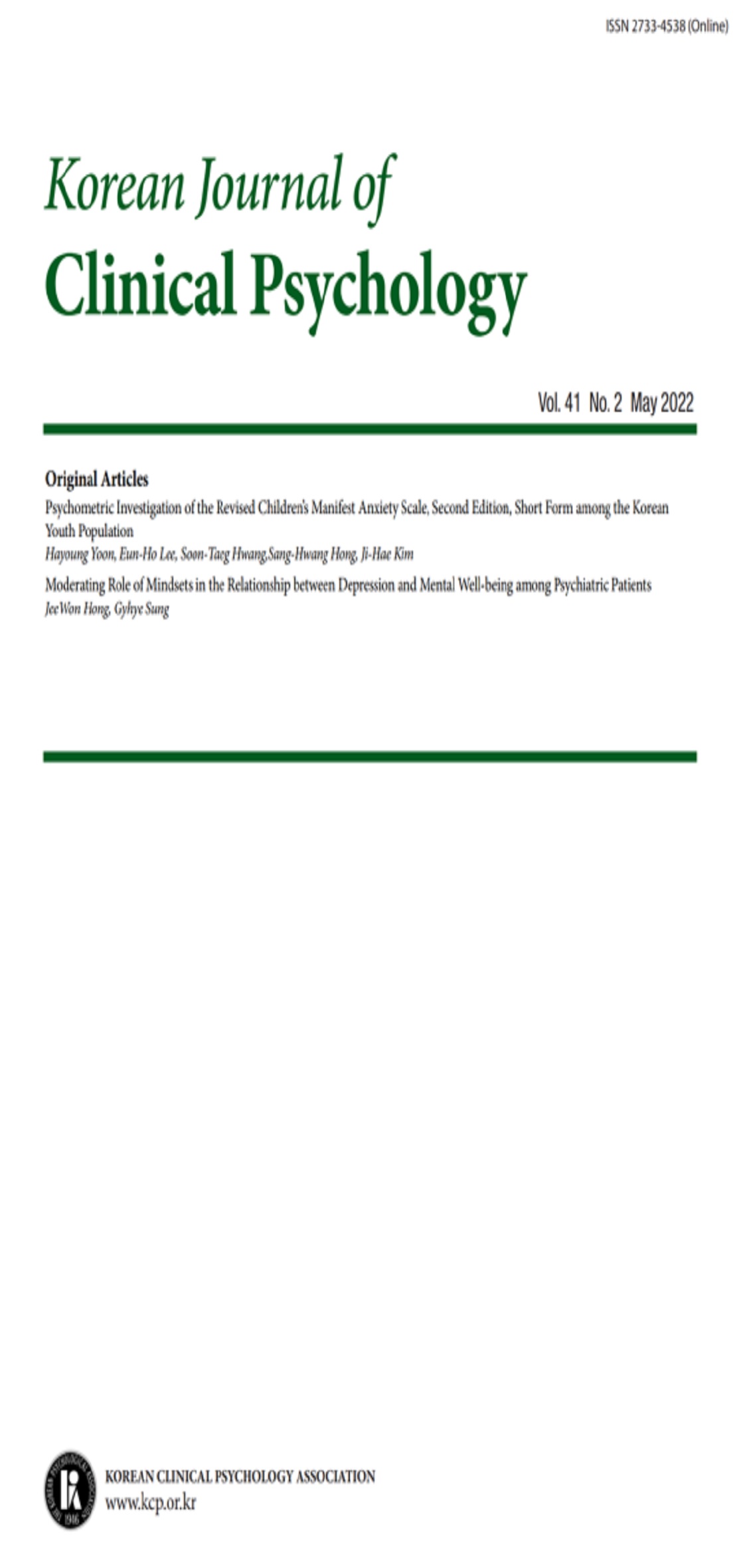open access
메뉴
open access
메뉴 E-ISSN : 2733-4538
E-ISSN : 2733-4538
본 연구는 사회공포증이 있는 사람들에게 낯선 이성과 사회적 상호 작용 시 긍정적 측면이 있음을 강조한 피드백과 부정적 측면이 없음을 강조한 피드백을 처치하였을 때 이 피드백이 다음 번 사회적 상호 작용에 대한 불안과 수행에 대한 예상에 어떠한 영향을 미치는지 알아보았다. 피험자는 총 40명으로 모두 남자이며 여자 연구 보조원 두 명과 각기 한 명씩 일대일 사회적 상호 작용을 두 번 실시하였다. 피험자는 각 피드백 조건에 따른 피드백 처치를 받은 후 두 번째 사회적 상호 작용에 대해 예상되는 불안과 수행 수준, 상태 불안을 평가하고 연이어 두 번째 사회적 상호 작용에 참여한 후 상태 불안, 피드백 특성과 피드백 수용성을 평가하였다. 두 번의 사회적 상호 작용 실험을 한 결과, 사회공포증 집단과 통제 집단 모두 예상 불안과 예상 수행에 대하여 피드백 종류에 따른 차이는 나타나지 않았다. 사회공포증 집단은 두 번째 사회적 상호작용에 대하여 통제 집단보다 더 높은 수준의 불안을 예상했고, 수행은 더 못할 것이라고 예상했다. 또한, 사회공포증 집단은 통제 집단에 비하여 두 번의 사회적 상호작용을 실시하면서 상태불안이 계속 유의미하게 감소하였다. 본 연구결과에 대한 제한점과 시사점을 논의하였다.
The purpose of this study was to examine effects of feedback during social interaction on predicted anxiety, predicted performance in individuals with social phobia and non-patient control. 20 individuals with social phobia were administered the Anxiety Disorders Interview Schedule for social phobia by a trained graduate student interviewer. Non-patient control group were 20 control college students. To establish interrater agreement, a second clinician independently rated a random sample selection of ADIS-R interviews. Interrater agreement was good (Kappa = .80). All participants completed the Social Avoidance and Distress Scale(SADS), Fear of Negative Evaluation-Brief(B-FNE), Social Performance Scale(SPS), Social Interaction Anxiety Scale(SIAS). The participants participated in two 5-min “getting acquainted” social exchanges with two assistants. After an initial interaction with one assistant, participants were shown the observer's “ratings and comments” which either framed the presence of positive social cues or the absence of negative social cues. They then rated state anxiety, predicted anxiety and performance in the upcoming second interaction, as well as their perceived valence and accuracy of feedback. After they participated second social interaction with another assistant, they rated state anxiety again. The results were as followings; first, regardless of feedback conditions, individuals with social phobia predicted higher anxiety and poorer performance for the upcoming interaction. Second, during two social interactions, the state anxiety of individuals with social phobia was reduced relative to non-patient control group regardless of the conditions of feedback. Third, individuals with social phobia accepted positive feedback less than non-patient control group. The implications for future research are discussed.
(1996) 스트레스, 사회적지지, 자아존중감과 우울 및 불안과의 관계,
(2001) 사회공포증 하위유형의 기억편향,
(1997) 한국판 사회공포증 척도(K-SAD, K-FNE)의 신뢰도 및 타당도 연구,
(1987) Attributional responses of anxious individuals to different patterns of social feedback:Nothing succeeds like improvement,
(2000) Social phobia and the interpretation of positive social events ,
(2004) Framing social information and generalized social phobia,
(1995) Social phobia and social appraisal in successful and unsuccessful social interactions,
(2001) A cognitive perspective on social phobia , Wiley.
(1993) Reliability of DSM-III-R Anxiety Disorder Categories:Using the Anxiety Disorders Interview Schedule-Revised,
(1987) Daily heterosocial interactions of high and low socially anxious college students,
(2002) Cognitive-behavioral group therapy for social phobia: Basic mechanism and clinical strategies., Guilford Press
(1997) The effects of blocked versus random presentation and semantic relatedness of stimulus words on response to a modified Stroop task among social phobics,
(1990185-195) Representations of the self in social phobia Vulnerability to social threat,
(1981) The psychology of social impact,
(1983) Social anxiousness:The construct and its measurement,
(2004) Framing social phobia information and generalized social phobia.,
(1998) Development and validation of measures of social phobia scrutiny fear and social interaction anxiety,
(1995) Comparison of social phobia subtypes using Stroop tests ,
(2002) Self-focused attention and negative affect: A meta- analysis.,
(1992) Discrepancy between self- and observer ratings of performance in social phobics Journal of Abnormal Psychology,
(1970) Manual for the State-Trait Anxiety Inventory, Consulting Psychology Press
(1996) Meta-analysis of cognitive- behavioral treatments for social phobia,
(2004) Interpretation and Judgemental biases in social phobia,
(1991) A comparison of social standards and perceived ability in anxious and nonanxious men,
(1995) Social anxiety and standard-setting following social success or failure,
(1997) Social phobia and positive social events: The price of success ,
(1995) Self-efficacy, anxiety, and phobic disorders, Plenum Press
(1996) Therapeutic changes in phobic behavior are mediated by changes in perceived self-efficacy, Guilford.
(1995) Social anxiety, fear of negative evaluation and the detection of negative emotion in others.,
